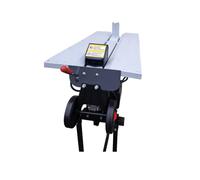Note: This text was created with the help of AI.








































- 1
- 2
- 3
- 4
- 5
- next page
Exclusive Offers for Log Splitters
There is no general answer to this question. It depends entirely on the type of wood and the length of the material to be split. Simple models have a splitting pressure of four to eight tons.
If you only want to split blocks of wood with a relatively short length into logs for your fireplace, a pressure of six tons is absolutely sufficient. For hardwoods it may be a little more.
Devices with more than twelve tons are real powerhouses that are suitable for professional forestry work.
Generally, horizontal log splitters require less oil - in some cases only 2.4 litres. In the standing version, up to five litres of hydraulic oil must be added to the tank.
The exact quantity varies from model to model. Exact litre specifications as well as information on the specification of the suitable oil can be found in the manufacturer's specifications of the respective device.
Two-handed operation is an absolute must. This means that you have to operate one button or lever with each hand. This sounds awkward at first, but it is actually for safety. This guarantees that you don't have a free hand with which you can accidentally reach into the device and bruise yourself.
Another indispensable feature is an electrical start-up safety device. This prevents the machine from starting unintentionally when the current flows again after an interruption in the circuit.
Other important safety features are the following:
- Safety emergency switch: when pressed, the log splitter stops immediately.
- Hose covers: These prevent oil from leaking from the hydraulic lines.
- Overload valve: It reduces the pressure when the splitting wedge hits material that is too hard, thus protecting the motor from damage.
The choice depends on the size of wood pieces you need to split: For small pieces, an axe is sufficient as it is light and easy to swing. For bigger pieces, you better use a log splitter.
Exclusive Offers for Log Splitters
If you're in the market for a log splitter, pricehunter.co.uk can help you find an array of offers tailored to your wood-splitting needs. From manual to electric options, the platform presents a variety of choices that can make your firewood preparation easier than ever. Let’s explore the essential aspects of log splitters, ensuring you make an informed decision when you explore your options.Types of Log Splitters
When choosing a log splitter, understanding the different types available can guide you in selecting the right one for your needs. Here are the main types:- Electric wood splitters – Ideal for home use and lighter tasks.
- Gas-powered options – Suitable for heavy-duty cutting and larger logs.
- Manual splitters – Cost-effective and perfect for occasional use.
- Heavy-duty hydraulic splitters – Designed for professional-grade performance.
- Pneumatic splitters – Great for industrial applications, offering high efficiency.
Essential Features to Consider
When searching for the right log splitter, several features can enhance your wood-splitting experience. Here’s what to consider:- Hydraulic force – Provides powerful splitting capabilities.
- Wedge design – Ensures effective cutting of tough logs.
- Cycle time – Determines how quickly you can split multiple logs.
- Portability – Look for models with wheels for easy transportation.
- Safety features – Such as automatic shut-off to prevent accidents.
Target Audiences for Log Splitters
Understanding who will benefit most from log splitters can help narrow down your options. Here are key target audiences:- Homeowners – Perfect for those who regularly use firewood for heating or cooking.
- Small business owners – Useful for those in landscaping or firewood sales.
- Outdoor enthusiasts – Ideal for campers or cabin owners requiring firewood.
- Farmers – Beneficial for those needing to prepare logs for livestock bedding.
- Contractors – Great for professionals needing a reliable tool for construction projects.
Popular Brands to Explore
Different brands offer varying quality and features in log splitters. Familiarizing yourself with reputable ones can enhance your shopping experience:- Champion – Known for durable and robust machines.
- WEN – Offers affordable options with reliable performance.
- Sun Joe – Focuses on electric models for home users.
- Ariens – Renowned for heavy-duty log splitters.
- Swisher – Features versatile splitters for various needs.
Accessories to Enhance Your Log Splitting Experience
Accessorizing your log splitter can improve efficiency and safety. Consider the following accessories:- Log splitter wedges – Enhance the splitting process by reducing resistance.
- Safety gloves – Protect your hands while operating the splitter.
- Gas or oil – Ensure your gas-powered units run smoothly.
- Extension cords – Necessary for electric models to reach distant logs.
- Log cradles – Help stabilize the logs for easier splitting.
Note: This text was created with the help of AI.